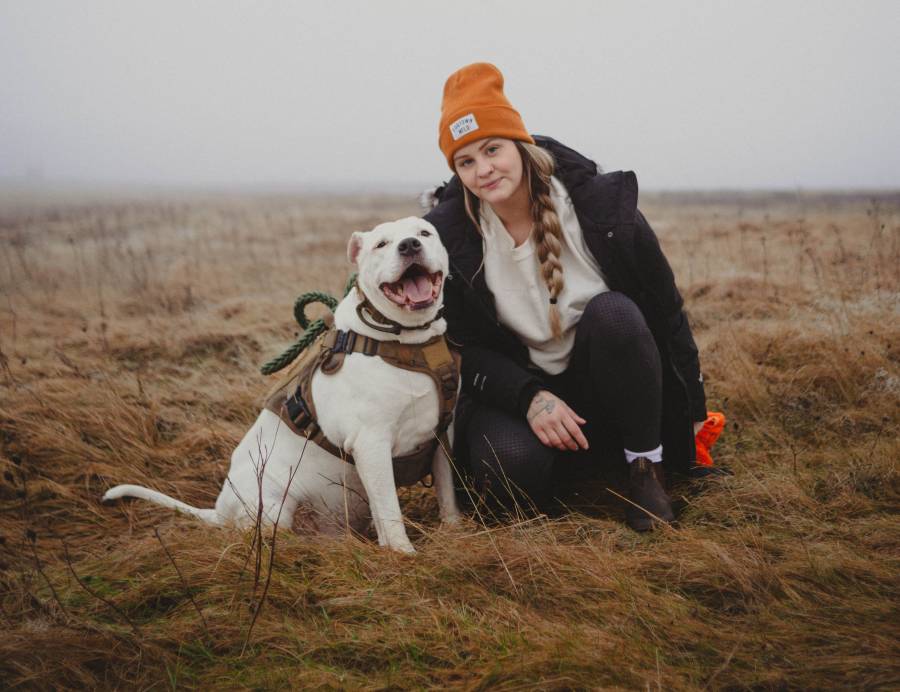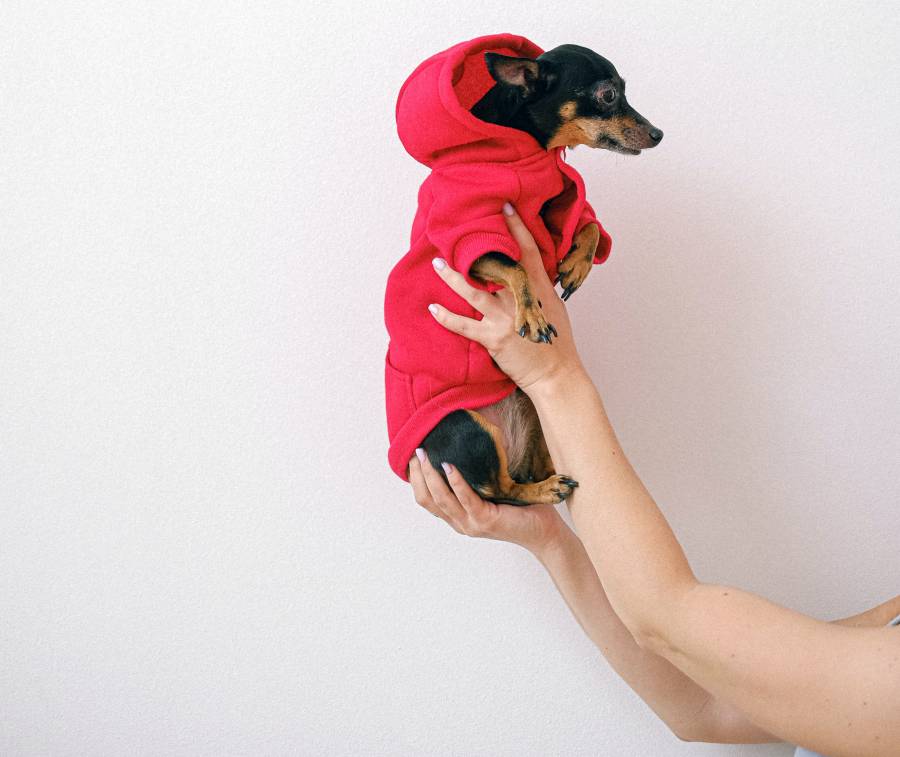Quick Navigation
Let’s say your dog breaks a bone in its knee.
Can you imagine that dog trying to stand and walk on it?
Putting weight on the fractured knee will not only increase your dog’s pain, but it will also cause the bones to separate, worsening the fracture.

Because bone rubbing against bone is excruciatingly painful, it’s critical to assess your dog’s injury.
Besides, experts recommend such owners create braces for their pets’ injured knees before taking them to the veterinarian.
So, how can you create such a splint? Read on this guide to learn how to make a dog knee brace at home.
A 3-Step Guide For Making A Dog Knee Brace
From a minor muscle strain to a complex fracture, a leg injury can vary in severity.
Until you can take your dog to the vet for a checkup, the injured leg must be immobilized if your dog sustains a leg injury.
If your pup has knee injuries or stifles joint arthritis, walking can be excruciatingly painful.
Every time he takes a step, your pup might begin to wretch in pain.
Injuries to the cranial cruciate ligament are common in dogs, especially older dogs.
If the knee injury is minor and will not necessitate surgery, canine hind leg braces may be required.
With the help of the hero brace, weight can be taken off an injured knee joint.
Step 1: Examine The Injured Knee
Make Sure Your Dog Is In A Secure Location
You’ll need to move your dog to a safe place to examine his knee.
After all, it’s critical to get him to lie down still to assess the injury.
Pick him up. Carry him to a safe area if he has been struck by a vehicle.
Don’t leave him lying in the middle of the highway.
If your dog is too big for you to carry alone, ask a friend to assist you in lifting him to safety.
You can encourage your dog to get up.
Let it limp to a safe location as a last resort.
Does Your Dog’s Knee Wobble Or Move In The Wrong Direction?
The knee moving in a direction isn’t supposed to be a sign of obvious knee instability in your dog.
Suppose your dog has a shinbone fracture, for example.
In that case, the shin bone may bend or bow when it should be straight, or it may angle in the wrong direction, such as pointing outwards when it should be parallel to your dog’s body.
Examine The Area Around The Bone To See If It Has Pierced The Skin
A brace will help to keep your dog’s injured bone from moving any further if it is sticking out through his skin.
Secure Your Dog So He Can’t Move Or Stand
If your dog’s injury requires a brace, tie him to a piece of furniture or a post to prevent him from standing or walking on his injured knee.
You could also request a neighbor’s help to watch him so he doesn’t put any weight on his injured knee.
It may be difficult to provide adequate support without making the ortho dog brace too loose or uncomfortable.
Your dog’s leg and the mount should be able to be separated by a finger.
If the knee brace prevents you from moving, it’s too tight.
Do not freak out if your pawl at first appears upset about wearing the brace.
Because of the current device on his branch, he may remain stationary.
Step 2: Get The Necessary Materials After Examining The Pet
Bring All Of The Materials Together In One Location
You don’t want to get the first few layers of the brace on only to realize you’re missing a bandage, so gather all of your materials in one place before starting to make the brace.
If you take a break to look for more materials, your dog may shake or move his knee unsupervised, undoing all of your hard work on the brace. Get:
- Adhesive bandage in the form of a roll (such as Elastoplast).
- Cotton padding bandage (such as Soffban) and cotton bandage (four to five rolls total).
- Crepe bandage in a roll (preferably a self-adhesive bandage such as Co-flex).
- Zinc oxide tape on a roll.
You’ll need a brace that’s the same breadth as the damaged knee bone and the same length.
You may use a ruler or a wooden spatula in a pinch as bracing. Also, cut the bandage material using scissors.
Ask For Assistance In Keeping Your Dog Motionless
If your dog is awake, having a friend or neighbor aid, you in keeping him motionless might be pretty helpful.
It will also keep him from removing the dressing halfway through.
If he becomes agitated due to the pain, your assistant can help him relax while you work on the brace.
Place your dog on a soft surface, with his injured knee raised in the air.
Make a smooth, padded surface for your dog with a rug or a towel, as he will be less likely to wiggle if he is comfortable.
Place yourself on one side of your dog, close to his paws.
Your assistant should stand with your dog’s back against their stomach; knees directed away from them and toward you.

Restrain Your Dog Gently With The Help Of Your Aide
If your dog is wriggling, place your assistant’s forearm over the dog’s neck.
Gently press their head to the floor.
With their free hand, your assistant may then grab your dog’s knee, which should be on the ground.
Your dog will not be able to get up if you pin down his head and clutch his knee.
Cover Your Dog’s Knee With A Single Layer Of Padding
Starting with a single layer of padding around your dog’s knee, apply the brace directly to the skin to avoid friction and irritation.
Rather than cushioning the damage, you want to keep the brace from resting against your dog’s skin at this point.
The brace may fall out of position if it has too much cushioning.
Step 3: Use A Splint To Brace The Dog’s Broken Knee
Bracing
Take four to six pieces of zinc oxide tape and cut them into four to six pieces.
Each strip should be twice as wide as the braced bone.
To help support the injury, place the brace against the padding.
Assemble the brace so that it fits snugly around the damaged region.
Place one strip at each end of the brace and wrap the tape around it to secure it.
Wrap the tape around the brace and Soffban, securing the brace to the knee.
If zinc oxide tape isn’t available, make do with what you have.
Sticky tape, duct tape, or even shoelaces wound around the brace and knee might be used instead of zinc oxide tape since it is fabric tape with adhesion.
The idea is to secure the brace against your dog’s knee and make it comfy.
Reapply Soffban And Co-flex
Apply the second layer of Soffban in the same manner as the first.
Then, using the same approach as before, open the sterile packing on the cotton bandage and weave a layer over the Soffban.
It should be done for three levels in total.
Adding more padding and bandaging to the brace helps it stay in place and immobilize fractures even more.
Keep the bandage clean and stiff by applying a protective covering like Co-flex.
Using the same approach as the Soffban, open the sterile wrapping and apply a coating of Co-flex.
Because Co-flex is stretchy, when it is put on a wounded knee in its stretched form, it will constrict and restrict blood flow to the knee.
As you wrap the Co-flex around your dog’s knee, always let off the tension on the roll, so the Co-flex isn’t strained.
To Keep Your Brace From Slipping Off, Use Elastoplast
Most knee dressings will slide off no matter how thoroughly you apply them.
Cut a length of adhesive dressing, Elastoplast, to fix the top of the dressing to the knee to prevent this from happening.
Cut a piece of Elastoplast long enough to wrap twice around the dressing’s top.
Half of the breadth should overhang the dressing, while the other half should overlap the hair on your dog’s knee.
Then, like a garter, wrap the Elastoplast around.
How to Make DIY Hip Harness for Your Dog
You can also make a temporary harness for your dog to help them with mobility.
To do this, you can use a canvas shopping bag of sufficient size.
Take the bag and cut out the shorter sides, leaving the longer sides and handles in place.
The result should be a shopping bag that you can open and lay flat.
You can now wrap this flat canvas fabric around the underbelly of the dog and use the handles to lift the dog.
This way, you can provide support to the dog and enable them to move more freely.
Verdict
Making a dog knee brace from scratch offers many advantages.
In general, a store-bought knee brace is more comfortable than one made from scratch.
However, there are several advantages to making your knee braces.
DIY fans may do it as a pastime, but it also has several benefits in certain circumstances.

A passionate content creator on pet behavior, nutrition choices, and health, Mike is an experienced pet expert. He has been writing on multiple websites to compensate for his passion for cats. Mike grieves around plenty of pets in his parents’ house. At the start of his career, he had a sturdy intention to be a part of pet care by any means.
With his affiliation to Purrfect n’ Pawesome, he found a way to satiate his craving to participate in pet health, wellness, and behavior analysis. He has been a significant part of our team and a major contributor in equipping our site with useful, authentic, and research-backed articles.
“I love pets as much as I love to travel to explore multiple places and lifestyles. I have been attached to this pawsome platform for many years, and my experience regarding pets has enhanced significantly by using various devices to write articles. I believe in writing my thoughts and experiences, so I try to write down the experience and learnings for my readers no matter where I am and what my mood is.”
